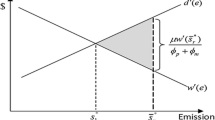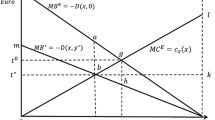Abstract
This paper explicitly defines enforcement quality and develops a model by incorporating enforcement quality and the firm's avoidance behavior. The results indicate that the effectiveness of environmental regulations is likely to depend upon the level of enforcement quality, as well as upon the nature of the firm's avoidance behavior. Policy instruments may become incompatible under certain circumstances. Enforcement quality should be properly targeted to enhance functional harmonization between instruments. The condition under which emission tax is more effective under imperfect enforcement than under complete enforcement is also identified.
Similar content being viewed by others
References
Battese, G. E. (1992), ‘Frontier production function and technical efficiency’, Agricultural Economics 7, 185–208.
Baumol, W. J. and W. E. Oates (1988), The Theory of Environmental Policy, 2nd ed., Prentice-Hall, Inc., New Jersey.
Burrows, P. (1979), ‘Pigouvian taxes, polluter subsidies regulations, and the size of a polluting industry’, Canadian Journal of Economics 12, 494–501.
Demski, J. S. and D. E. M. Sappington (1987), ‘Hierarchical regulatory control’, Rand Journal of Economics 18, 369–383.
Dewees, D. N. (1983), ‘Instrument choice in environmental policy’, Economic Inquiry 21, 53–71.
Downing, P. and W. Watson Jr. (1974), ‘The economics of enforcing air pollution controls’, Journal of Environmental Economics and Management 1, 219–236.
Epple, D. and M. Visscher (1984), ‘Environmental pollution: modeling occurrence, detection, and deterrence’, Journal of Law and Economics 27, 29–60.
Fuller, D. A. (1987), ‘Compliance, avoidance, and evasion: emissions control under imperfect enforcement in steam-electric generation’, Rand Journal of Economics 18, 124–137.
Greenwood, J. and P. McAfee (1991), ‘Externalities and asymmetric information’, Quarterly Journal of Economics 106, 103–121.
Harford, J. D. (1978), ‘Firm behavior under imperfectively enforceable pollution standards and taxes’, Journal of Environmental Economics and Management 5, 26–43.
Huang, Chung-Huang (1991), Impact of Effluent Standards on Swine Industry and Its Coping Strategy, report submitted to the Council of Agriculture, Taiwan.
Huang, Chung-Huang (1993a), ‘Effectiveness of environmental regulations with incomplete enforcement’, paper presented at the Fourth Annual Conference of the European Association of Environmental and Resource Economics, June 30–July 3, Fontainebleau, France.
Huang, Chung-Huang (1993b), ‘Mixed environmental regulations and transfer payments under incomplete enforcement: a multiple-principals agent approach, paper presented at the Annual Meeting of Western Agricultural Economics Association, July 11–14, Edmonton, Canada.
Huang, Chung-Huang (1996), ‘Hierarchical government, environmental regulations, transfer payments, and incomplete enforcement’, in R. Mendelsohn and D-G Shaw (eds.), The Economics of Pollution Control in the Asian Pacific. Kluwer Academic Publishers, Amsterdam. (forthcoming)
Jones, C. A. (1989), ‘Standard setting with incomplete enforcement revisited’, Journal of Policy Analysis and Management 8, 72–87.
Jones, C. A. and S. Scotchmer (1990), ‘The social cost of uniform regulatory standards in a hierarchical government’, Journal of Environmental Economics and Management 19, 61–72.
Kambhu, J. (1989), ‘Regulatory standards, noncompliance, and enforcement’, Journal of Regulatory Economics 1, 103–114.
Kambhu, J. (199), ‘Direct controls and incentive systems of regulations’, Journal of Environmental Economics and Management 19, s72–s85.
Kopp, R. J. and W. E. Diewert (1982), ‘The decomposition of frontier cost function deviations into measures of technical and allocative efficiency’, Journal of Econometrics 19, 319–331.
Linder, S. H. and M. E. McBride (1984), ‘Enforcement costs and regulatory reform: the agency and firm response’, Journal of Environmental Economics and Management 11, 327–346.
Polinsky, A. M. and S. Shavell (1982), ‘Pigouvian taxation with administrative costs’, Journal of Public Economics 19, 385–394.
Roberts, M. J. and M. Spence (1976), ‘Effluent charges and licenses under uncertainty’, Journal of Public Economics 5, 193–208.
Russell, C. S. (1990), ‘Game models for structuring monitoring and enforcement systems’, Natural Resource Modeling 4, 143–173.
Schmidt, P. and C. A. K. Lovell (1979), ‘Estimating technical and allocative inefficiency relative to stochastic production and cost frontier’, Journal of Econometrics 9, 343–336.
Shaffer, S. (1990), ‘Regulatory compliance with nonlinear penalties’, Journal of Regulatory Economics 2, 99–103.
Shavell, S. (1980), ‘Risk sharing and incentives in the principal and agent relationship’, Bell Journal of Economics 10, 55–73.
Spiller, P. T. (1990), ‘Politicians, interest groups, and regulators: a multiple-principals agency theory of regulations, or “L upet them be bribed’, Journal of Law and Economics 33, 65–101.
Viscusi, W. K. and R. J. Zeckhauser (1979), ‘Optimal standards with incomplete enforcement’, Public Policy 27, 437–456.
Wertz, K. L. (1974), ‘Short-run effects of an increased effluent charge in a competitive market’, Canadian Journal of Economics 7, 676–682.
Xepapadeas, A. P. (1991), ‘Environmental policy under imperfect information: incentives and moral Hazard’, Journal of Environmental Economics and Management 20, 113–126.
Zuckerman, S., J. Hadley, and L. Iezzoni (1994), ‘Measuring hospital efficiency with frontier cost function’, Journal of Health Economics 13, 225–280.
Author information
Authors and Affiliations
Rights and permissions
About this article
Cite this article
Huang, CH. Effectiveness of environmental regulations under imperfect enforcement and the firm's avoidance behavior. Environmental and Resource Economics 8, 183–204 (1996). https://doi.org/10.1007/BF00357363
Accepted:
Issue Date:
DOI: https://doi.org/10.1007/BF00357363




